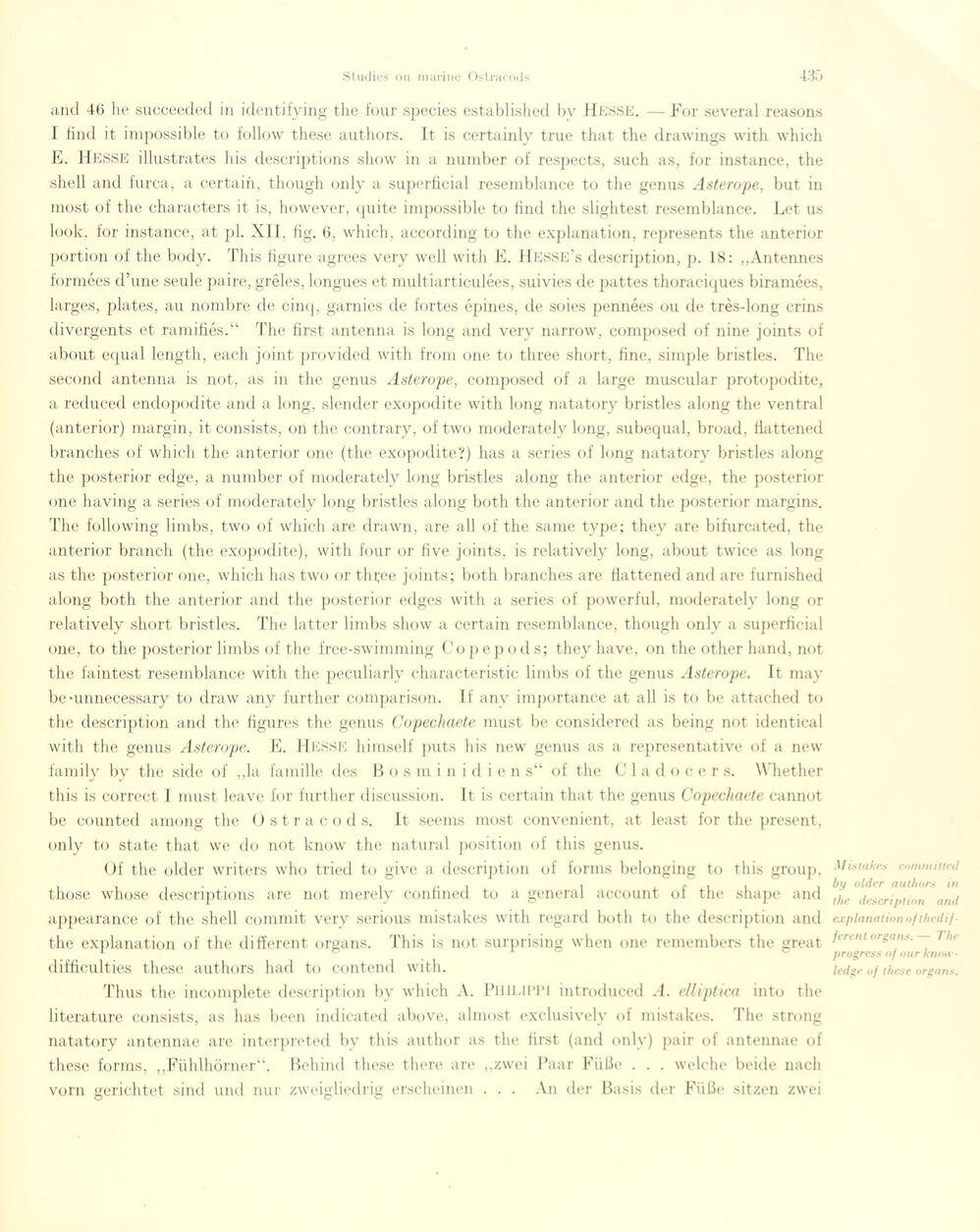
Full resolution (JPEG) - On this page / på denna sida - Sidor ...

<< prev. page << föreg. sida << >> nästa sida >> next page >>
Below is the raw OCR text
from the above scanned image.
Do you see an error? Proofread the page now!
Här nedan syns maskintolkade texten från faksimilbilden ovan.
Ser du något fel? Korrekturläs sidan nu!
This page has never been proofread. / Denna sida har aldrig korrekturlästs.
and 46 he succeeded in identifying the four species established bv Hesse. — For several reasons
I find it impossible to follow thèse authors. It is certainly true that the drawings with which
E. Hesse illustrâtes bis descriptions show in a number of respects, such as, for instance, the
shell and furca, a certain, though only a superficial resemblance to the genus Asterope, but in
most of the characters it is, however, quite impossible to find the slightest resemblance. Let us
look, for instance, at pi. XII, fig. 6, which, according to the explanation, represents the anterior
portion of the body. This figure agrees very well with E. Hesse’s description, p. 18: „Antennes
formées d’une seule paire, grêles, longues et multîarticulées, suivies de pattes thoraciques biramées,
larges, plates, au nombre de cinq, garnies de fortes épines, de soies pennées ou de très-long crins
divergents et ramifiés.“ The first antenna is long and very narrow, composed of nine joints of
about equal length, each joint provided with from one to three short, fine, simple bristles. The
second antenna is not, as in the genus Asterope, composed of a large muscular protopodite,
a reduced endopodite and a long, siender exopodite with long natatory bristles along the ventral
(anterior) margin, it consists, on the contrary, of two moderately long, subequal, broad, fiattened
branches of which the anterior one (the exopodite?) has a series of long natatory bristles along
the posterior edge, a number of moderately long bristles along the anterior edge, the posterior
one having a series of moderately long bristles along both the anterior and the posterior margins.
The following limbs, two of which are drawn, are all of the same type; they are bifurcated, the
anterior branch (the exopodite), with four or five joints, is relatively long, about twice as long
as the posterior one, which has two or thi,ve joints; both branches are fiattened and are furnished
along both the anterior and the posterior edges with a series of powerful, moderately long or
relatively short bristles. The latter limbs show a certain resemblance, though only a superficial
one, to the posterior limbs of the free-swimming Copepods; they have, on the other hånd, not
the faintest resemblance with the peculiarly characteristic limbs of the genus Asterope. It may
be-unnecessary to draw any further comparison. If any importance at all is to be attached to
the description and the figures the genus Copechaete must be considered as being not identical
with the genus Asterope. E. 11 essi: himself puts his new genus as a representative of a new
family by the side of „la famille des Bos m i n i d i e n s“ of the Cladocers. Whether
this is correct I must leave for further discussion. It is certain that the genus Copechaete cannot
be counted among the O straco d s. It seems most convenient, at least for the present,
only to state that we do not know the natural position of this genus.
Of the older writers who tried to give a description of forms belonging to this group,
those whose descriptions are not merely confined to a general account of the shape and
appearance of the shell commit very serious mistakes with regard both to the description and
the explanation of the different organs. This is not surprising when one remembers the great
difficulties these authors had to contend with.
Thus the incomplete description by which A. PHILIPPI introduced A. elliptica into the
literature consists, as has been indicated above, almost exelusively of mistakes. The strong
natatory antennae are interpreted by this author as the first (and only) pair of antennae of
these forms, „Fühlhörner“. Behind these there are „zwei Paar Füße . . . welche beide nach
vorn gerichtet sind und nur zweigliedrig erscheinen . . . An der Basis der Füße sitzen zwei
M istakcs conunittcd
bi/ older authors in
the description and
explanation of thedif •
ferent organs.— The
progress of our
knowledge of these organs.
<< prev. page << föreg. sida << >> nästa sida >> next page >>